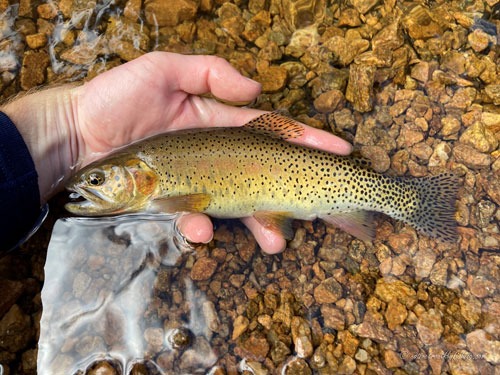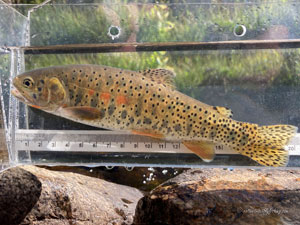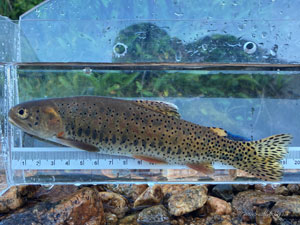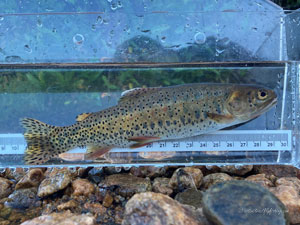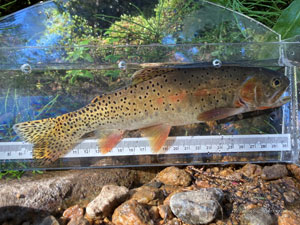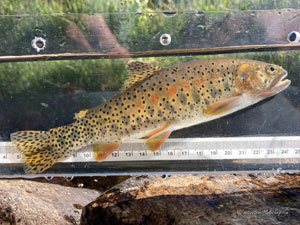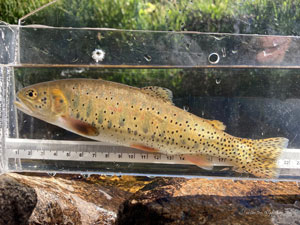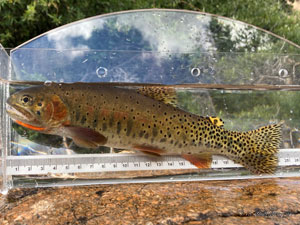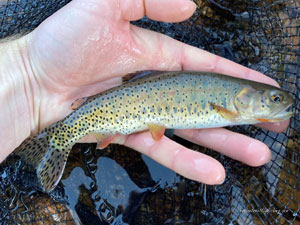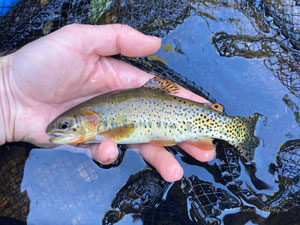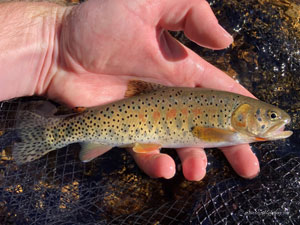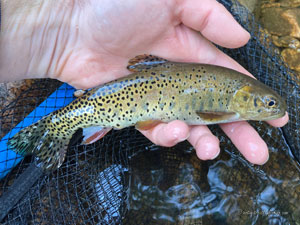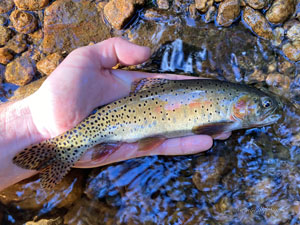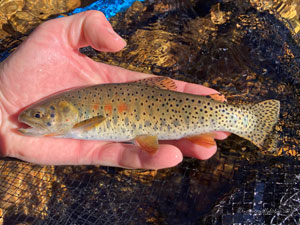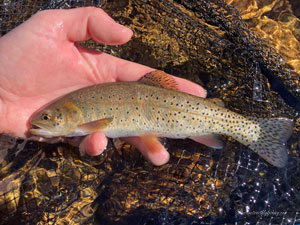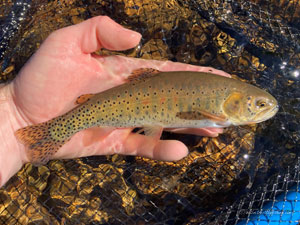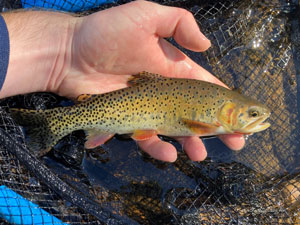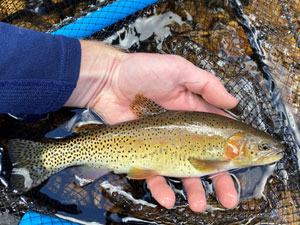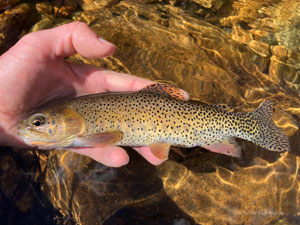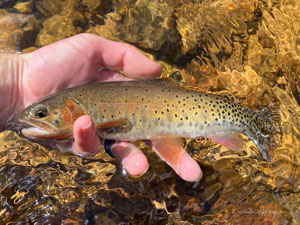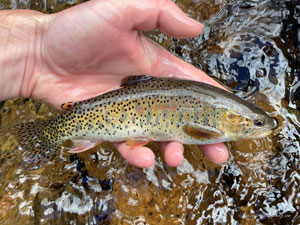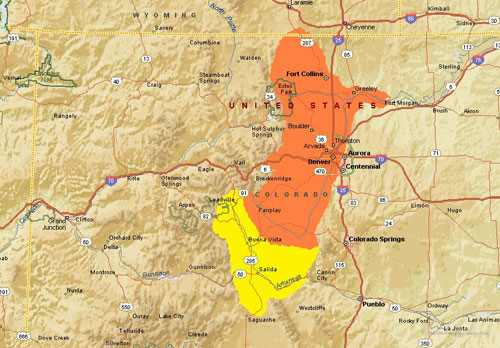Greenback Cutthroat
Oncorhynchus virginalis stomias
A Greenback from a high elevation stream in Colorado.
Introduction
The Greenback Cutthroat is a subspecies of Rocky Mountain Cutthroat native to the South Platte watershed of Colorado and a small part of Wyoming and is designated as Colorado’s state fish. Greenback Cutthroat were first named Salmo stomias in 1857 (Girard 1857), however the labeling of these original specimens made it unclear where they had originated, although it was long believed that they came from the South Platte River in Colorado (Behnke 2002, Trotter 2008). This confusion was recently cleared up when genetic evidence indicated that the fish classified as Salmo stomias were in fact collected from the Rio Grande watershed and thus were Rio Grande Cutthroat (Rogers et al. 2018). Despite this issue, with the long history of the scientific name stomias being used for Greenback Cutthroat, experts indicate that it should be revalidated as the official name for this subspecies of Cutthroat (Trotter et al. 2018). It was once believed that Greenback Cutthroat were also native to the Arkansas basin, as early reports indicated that “green-back trout” were very common in the watershed (Jordan 1891). However, genetic analysis of museum specimens from the Arkansas basin has revealed that these “green-back trout” were a unique lineage of Colorado River Cutthroat (see Hayden Creek Cutthroat on the Colorado River Cutthroat page) (Metcalf et al. 2012, Rogers 2021). Based on genetic evidence, Greenback Cutthroat are most closely related to the Colorado River Cutthroat (green lineage) but are unique enough to warrant subspecies status and likely diverged from Colorado River Cutthroat about 1.3 million years ago (Metcalf et al. 2012, Rogers et al. 2018, Shiozawa et al. 2018, Trotter et al. 2018). Greenback Cutthroat are very susceptible to nonnative trout introductions and environmental alternations and were completely extirpated from the South Platte watershed by the 1930’s. Today all existing populations are derived from a single small, translocated population in Bear Creek (Arkansas drainage) on Pikes Peak.
Life History Information
The Greenback Cutthroat historically occurred as stream resident, fluvial (river migrant) and adfluvial (stream to lake migrant) populations. However, native fluvial and adfluvial populations were lost and only a single transplanted stream resident population remained at the time that they were determined to be Greenback Cutthroat in 2012 (Metcalf et al. 2012) so little is known about the life history of these fish. While no formal life history studies have been conducted on Greenback Cutthroat to date, historical accounts as well as studies on Green River and Colorado Cutthroat within the South Platte drainage provide some insights on their life history. It is believed that stream resident populations of Greenback express similar life history patterns to other Rocky Mountain Cutthroat subspecies, being spring spawners and generalists in their feeding habits. The diet of these Cutthroat consists of aquatic and terrestrial invertebrates and with the high elevation habitats in which they are found, growth is slow, and they generally reach a maximum size of 8” to 12” (20 to 30 cm). Like other subspecies of Cutthroat, Greenbacks spawn during spring, but with most existing populations occurring at elevations of over 10,000 feet (3,048 m) where snow melts out late water temperatures do not warm enough for spawning until between late-June to early August (Trotter 2008). Fry survival in these high elevation streams is greatly influenced by water temperatures and is often limited by the cold-water temperatures (Coleman and Fausch 2007). Fluvial populations of Greenback Cutthroat once occurred throughout their native range, historical accounts indicate that these reached a maximum size of 1 to 2 pounds (0.5 to 0.9 kg) or 15” to 19” (38 to 48 cm), but most did not exceed 12” (30 cm) (Trotter 2008). Fluvial Greenback Cutthroat likely made seasonal migrations between high elevation locations and lower elevation locations to maximize their growth potential. Historical accounts note native Cutthroat in the South Platte drainage running downstream in the fall, which was likely to seek overwintering habitat as is observed in other Cutthroat subspecies (Field and Farm 1889). Currently the only lake dwelling population of Greenback Cutthroat is found in Zimmerman Lake. Spawning in this population occurs from mid-June through mid-July but varies depending on snowpack and water temperatures (Rogers 2020). Compared to other Cutthroat populations across the Rocky Mountains, adfluvial Greenback Cutthroat from Zimmerman Lake have the lowest optimal growth temperature range at just 59.2 °F (15.1 °C) (Rogers 2021) and appear to reach a maximum size of around 18” (46 cm).
Status
The Greenback Cutthroat are one of the most heavily impacted subspecies of Rocky Mountain Cutthroat and with only a handful of small populations on the landscape today, their future is still extremely tenuous. The story of the Greenback Cutthroat and the ongoing efforts to pull the back from the brink of extinction is an extremely complicated one that dates to the earliest days of pioneer settlement in the 1850’s. The Greenback Cutthroat are native to the Front Range of the Colorado Rockies and early reports indicate that Greenback Cutthroat once thrived in abundance in the streams of the South Platte drainage. However, as settlers from the United States pushed westward, the native range of these trout became home to the largest population centers in Colorado and was also held some of the richest mineral deposits of gold, silver, lead zinc, tungsten, molybdenum, uranium and rhodochrosite in the region, spelling disaster for the Greenback Cutthroat. While gold had been found in the South Park valley along the Middle Fork of the South Platte River as early as 1803, it wasn’t until 1859 when gold was discovered along Tarryall Creek that the Pikes Peak Gold Rush kicked off. At its peak, this gold rush brought over 10,000 people to the South Park valley accounting for approximately a third of the population of settlers in Colorado at the time. Attempts to extract the mineral wealth of the Rockies hit Greenback Cutthroat populations hard as these early mining operations paid no mind to environmental impacts. With gold initially found in stream beds, initially panning and sluicing was used, but this eventually evolved into much more destructive methods such as hydraulic mining and dredging. The result was that streams were stripped of riparian vegetation, diverted, filled with sediment, and contaminated lethal amounts of heavy metals. All these factors had negative impacts on trout and resulted in a loss of insect life and thus reduced food supply, a loss of rearing habitat, eggs suffocating and just general high mortality levels. Even when adult fish are able to survive in streams with elevated levels of heavy metals from mining, their eggs fail to survive incubation and successfully hatch (USFWS 1998). Early reports describing mining impacts tell of entire valleys torn up, with streams running muddy yellow or red and completely devoid of life (Jordan 1891). As the easy to reach gold dwindled, in the early 1860’s miners shifted to hard rock mining and once gold deposits ran dry miners shifted their attention to silver, lead, zinc and other minerals. This created a cycle of over a hundred years of mining in the region and left behind a marred landscape with little thought for restoring the once pristine environment. Along with mining came the need to transport and smelt the ore and the construction of roads and the Denver Southpark and Pacific Railroad in 1879 which cut across the South Platte drainage and resulted in further damage to streams and increased access also increased fishing pressure. Early smelting had none of the emission restrictions today and resulted in air pollution and acid precipitation (acid rain and snow) lowering the pH levels of streams and effecting their productivity. Woodward et al. (1991) showed that the alevin stage of Cutthroat in the South Platte drainage is heavily impacted by low pH levels and that at levels below 5.0 they experienced a 68% decrease in survival. The legacy of these mining operations continues to haunt the environment today, with costly efforts required to restore many of these streams to a state where they can sustain viable populations of trout.
While mining affected high elevation populations, overfishing and agriculture impacted Greenback Cutthroat in lower elevation streams. Like mining, early agriculture in the region paid little heed to the environment, with streams being diverted for water with no thoughts paid to instream flow or trout becoming entrained in the irrigation ditches. In 1889, Colorado Fish Commission Gordan Land was noted complaining that the native trout had the habit of running downstream in the fall and where many of them are lost in irrigation ditches (Field and Farm 1889). Similarly, David Starr Jordan indicated even the largest streams of the South Platte drainage would run dry in the summer due to the heavy water use for agriculture and many thousands of trout were left to perish in the fields (Jordan 1891). On top of the habitat destruction, as pioneers and miners rushed into the region hoping to start a new life or get rich quick, trout were harvested by the wagon load as a cheap way to keep the growing communities fed. While territorial and later state officials attempted to regulate the fishery, limits were set too high, and rules were poorly enforced. As a result, overharvest continued and destructive methods were often used, with some fisherman noted for resorting to dynamite to get their hands on trout in the South Platte River near Denver (Trotter 2008). Not surprisingly, Greenback Cutthroat populations began to disappear due to the combined impacts and efforts to restore the fishery would be the last straw for these Cutthroat.
In a cycle that has repeated itself over and over across the west, as the native Cutthroat began to disappear fisheries managers turned to hatcheries and the introduction of nonnative fish as their solution. With Brook Trout, Brown Trout and Rainbow Trout all being stocked extensively throughout the South Platte watershed. With Greenback Cutthroat evolving in isolation of other trout species, these nonnatives, quickly replaced them with Brook Trout taking hold in the higher elevation streams, while Rainbow and Brown Trout dominated the larger lower elevation streams. As an indication of just how effective Brook Trout are at displacing Rocky Mountain Cutthroat like the Greenback, six years after Cutthroat were reintroduced above a barrier Black Hollow Creek, two Brook Trout were discovered above the barrier and within just four years only Brook Trout could be found within a mile of the barrier (Behnke and Zarn 1976, Behnke 1979). What makes Brook Trout such effective competitors with Cutthroat is the fact that they spawn in the fall, and their offspring emerge much earlier than the spring spawning Cutthroat. This allows young of the year Brook Trout to reach larger sizes and outcompete young of the year Cutthroat for the best holding water, resulting in lower growth and survival rates for the Cutthroat (Behnke 2002). Brown Trout have a similar impact on Greenback Cutthroat and have been shown to be much more aggressive than equal sized Rocky Mountain Cutthroat are even able to outcompete Cutthroat that are 1.27 times longer and 1.69 times heavier than them (Wang 1989, Wang and White 1994). In addition to displacement of Greenback Cutthroat via competition, Greenback Cutthroat also readily hybridized with Rainbow Trout and other subspecies of Cutthroat resulting in a loss of genetic integrity of in many populations. As the introduction of nonnative trout began to gain momentum and locals presented their concern about the loss of the native trout, the Colorado Fish Commissioner Gordan Land responded with the following statement.
“It is a curious thing that eastern trout grow faster than the native, and I have known them to increase their pounds in two years. They are also found to be particularly adapted to the higher altitudes, above timber line. The lakes up there are full of insects, but have no native fish in them. The eastern trout seem to revel when they get in there. Another reason also is that they stay up. That is they haven't got the habit of the natives of running down steams in the fall. The latter persist in doing that and many of them get lost in the irrigating ditches. There is a lot of nonsense talked by people who know nothing of the subject about the foolishness of breeding these fish. I think that sixteen years' experience is better than theory. As an instance, as many eastern fish are now caught in the Platte as natives. We stocked all the streams tributary to it from Kenosha hill down (Field and Farm 1889)."
Clearly the value at the time was placed on maintaining the fishery, with little thought paid to the status of the Greenback Cutthroat and as a result by 1937 some sources considered them to be extinct (Greene 1937). However, by the early 1970’s two pure populations of Cutthroat presumed to be Greenbacks had been found in the South Platte drainage, with one in Como Creek and another in the headwaters of the South Fork of the Cache La Poudre River (Trotter 2008). Between them these two populations only provided 2.9 miles (4.6 km) of stream habitat between them and were believed to support less than 2,000 Cutthroat. As a result, when the Endangered Species Act was adopted, the Greenback Cutthroat were listed as Endangered (USFWS 1967). This sparked an intensive search for additional populations as well as an aggressive recovery program and by 1978 with several successful reintroductions the Greenback Cutthroat were downlisted to threatened (USFWS 1978). These recovery efforts continued to gain momentum and by 1998 five additional pure populations of Cutthroat were discovered in the South Platte watershed an additional 10 stable self-sustaining populations were established through conservation efforts (USFWS 1998). Due to the extensive introduction of nonnative species, Greenback Cutthroat recovery efforts often required that nonnative trout were first eradicated, before pure Greenback Cutthroat could be restocked into the stream or lake in question. However, eliminating all these nonnative trout was not always guaranteed and Harig et al. (2000) showed that 48% of Greenback Cutthroat restoration projects that failed were a result of re-invasion by nonnative salmonids. Despite the sometimes-bumpy road, recovery efforts continued apace, and many viewed the recovery of the Greenback Cutthroat as one of the great conservation success stories (Trotter 2008).
While conservation efforts continue apace and many viewed the recovery of the Greenback Cutthroat as a great success story, the narrative began to take a sudden turn in the late 1990’s. At that time, a biologist named Gary Dowler with the Colorado Division of Wildlife had recently discovered a population of Cutthroat that appeared to be Greenback in a small stream named Severy Creek on the slopes of Pikes Peak in the Arkansas River basin. That discovery caused him to search the area for additional populations in the area and after some research he discovered a past genetic test that had found Greenback x Rainbow Trout hybrids on the lower reaches of a small stream named Bear Creek also in the Arkansas basin. Upon sampling the upper reaches of Bear Creek above a natural waterfall, he collected fin clips from a rather unique looking Cutthroat population that inhabited 4 miles (6.4 km) of habitat. While the genetics of samples collected from Severy Creek came back as pure Greenback Cutthroat, the Bear Creek samples came back as something different and didn’t align with any known Cutthroat lineages. With the uncertain nature of the Bear Creek population, conservation efforts were instead focused on Severy Creek and Bear Creek was put on the back burner but picked the nickname of weird Bear Creek from the biologists. By doing some digging, biologists found historical records that indicated that Bear Creek was originally fishless, but in 1882 and early homesteader built a trout pond at the headwaters and likely obtained Greenback Cutthroat from one of the private hatcheries operating on tributaries to the South Platte River indicating that these fish were likely Greenback Cutthroat (Kennedy 2010).
In 2007, Greenback Cutthroat conservation efforts were thrown for a loop, when a genetics study indicated that there were a number of Greenback Cutthroat or what the researchers referred as the “green lineage” populations found west of the Continental Divide and that there were also number of Colorado River Cutthroat referred to as the “blue lineage” populations found east of the continental divide in the native range of the Greenback Cutthroat, which the authors attributed to past stock events (Metcalf et al. 2007). At the time of this discovery, Greenback Cutthroat had been reintroduced to around 60 different populations, with many of these populations in Rocky Mountain National Park, but the results of the genetics study indicated that many of these populations had been stocked with Colorado River (blue lineage) Cutthroat and that the primary broodstock used was a hybrid of Colorado River Cutthroat from Hunter Creek (blue lineage) and Greenback Cutthroat from Como Creek (Green lineage) (USFWS 1998, Young et al. 2002, Metcalf et al. 2007). With the fate of the entire Greenback Cutthroat recovery effort up in the air, the researchers from the 2007 study were commissioned to conduct a follow-up study to clarify findings of their previous study. To do this the researchers successfully extracted DNA from museum specimens collected across the state Colorado between 1857 and 1889 and compared them to existing populations (Metcalf et al. 2012). While this study provided clarity on the status of Greenback Cutthroat, it also upended nearly everything that was previously believed about Cutthroat classification in the southern Rocky Mountains.
The key finding of the 2012 genetics study was that instead of the four subspecies of Cutthroat that had been recognized in Colorado, there were actually six, the Green River, Colorado River, San Juan, Rio Grande, Yellowfin and Greenback Cutthroat. Of great importance to Greenback Cutthroat recovery, the researchers showed that the blue lineage Colorado River Cutthroat and green lineage Greenback Cutthroat did not match the museum specimens from the South Platte River but instead were distinct subspecies, now recognized as Green River Cutthroat (blue lineage) and Colorado River Cutthroat (green lineage) (Metcalf et al. 2012). Further, examining stocking records showed that by 1909, 29 million green lineage Colorado River Cutthroat from the Grand Mesa had been stocked across Colorado and that between 1914 and 1925 26 million Green River Cutthroat from Trappers Lake had been stocked across the state (Rogers and Kennedy 2008, Rogers et al. 2018). Using these records, the authors concluded that all the remnant populations used for Greenback Cutthroat recovery in the South Platte drainage, had been introduced from west of the Continental Divide. Another finding was that Greenback Cutthroat were not native to the Arkansas drainage. Instead, the Yellowfin Cutthroat (now extinct) and a unique strain of Colorado River Cutthroat only remaining in one stream (South Prong of Hayden Creek – see Colorado River Cutthroat) appeared to be the original trout of the Arkansas basin. However, the real kicker for Greenback Cutthroat recovery was that only a single population remained that matched the museum specimens, and sure enough it was weird Bear Creek. (Metcalf et al. 2012).
While the news certainly could have been worse, with the Greenback Cutthroat following the Yellowfin into extinction, overnight more than 40 years of intensive effort to recover the Greenback Cutthroat was reset. It is hard to place blame on anyone for this mistake, as fisheries officials were doing the best they could with the information and techniques that they had at the time. However, the mislabeled type specimens for Greenback Cutthroat certainly muddied the waters of what constituted a Greenback Cutthroat and the extensive history of stocking had effectively masked the existence of several distinct lineages of Cutthroat. Regardless, recovery efforts were back at ground zero, but experts agreed that immediate action was needed to safeguard and replicate the Bear Creek population (USFWS 2014). The first steps to safeguard the population required protecting the fish habitat and as such, fishing was closed, and the Bear Creek trail was improved to reduce erosion and sedimentation. However, replicating the Bear Creek population presented its own set of issues. First the population was rather small and fragile and was believed to only hold around 700 Cutthroat. However more problematic was that due to the small population size and the fact that the population had been established from just a handful of fish from the South Platte drainage a genetic bottleneck had occurred in the population. A genetic bottleneck typically occurs when a population is greatly reduced in size or founded from small number of individuals and results in a loss of genetic diversity. This often results in inbreeding, genetic drift, lower fitness and genetic deformities which is exactly what Colorado Parks and Wildlife observed when they sought to develop a broodstock from Bear Creek for future reintroduction efforts. When spawned, some of the offspring in the hatchery displayed deformities, which most often presented themselves as misshaped jaws, but some fish also showed truncated bodies as well. These issues were addressed as best as they could be with a selective breeding program to maximize genetic diversity and to find a site that could serve as a wild broodstock source. As such when reintroduction efforts began the first location selected was Zimmerman Lake which sits at 10.495 ft (3,200 m) in the Cache La Poudre drainage. In 2013, nonnative trout were eliminated from Zimmerman Lake and 1,000 yearling Cutthroat from Bear Creek were planted in August of 2014 (Rogers 2020).
With annual stocking of additional Greenback Cutthroat and a few years to mature, Zimmerman Lake proved successful and even boasted a six-fold increase in survival rates from the egg to the fingerling stage when compared captive broodstock fish from Bear Creek at Leadville national Fish Hatchery (Rogers 2020). Additionally, Zimmerman Lake was able provide anglers with their first opportunity to fish for Greenback Cutthroat. With a stable broodstock source secured at Zimmerman Lake, reintroduction efforts began in earnest and in 2016, Colorado Parks and Wildlife staff began stocking Greenback Cutthroat into several streams in the headwaters Clear Creek drainage. In the most heavily surveyed of these streams, fish appeared to have a 30% annual survival rate and by 2017 biologist observed 435 trout per mile of stream habitat. Stocking in these streams continued for three years, followed by survey efforts to determine if the fish had established self-sustaining populations and sure enough in 2021, Greenback Cutthroat had successfully spawned in the wild for the first time in their native range since at least the 1930’s. While most of the reintroduced Greenback Cutthroat populations have been in small isolated high elevation (above 10,000 feet) streams, in 2018 Colorado Parks and Wildlife initiated a reintroduction effort in a lower elevation stream (7,500 feet) in the Cache la Poudre drainage. The initial phase of the project will require the removal of nonnative Brook and Brown Trout and will target the 4 miles (6.4 km) of stream habitat, with the overall project set to restore Greenback Cutthroat to 14 miles (22.5 km) of interconnected habitat. While this project represents a major milestone for Greenback Cutthroat recovery, an even more ambitious plan is in the works to reintroduce Greenback Cutthroat to nearly 40 miles (64 km) of connected stream and lake habitat, as well as Long Draw Reservoir in the upper reaches of the Cache la Poudre River in Rocky Mountain National Park and the Arapaho-Roosevelt National Forest. This project came about as the culmination of many years of legal battles of mitigation for Long Draw Reservoir with a trust fund set aside for its implementation. The reintroduction will need to be done in pieces, using temporary barriers to isolate stream reaches so that nonnatives can be removed, and Greenback Cutthroat can be planted in the streams. It is expected that each component of the project will require two to three years to complete with the entire project being completed over the course of 10 to 15 years. However, once finished it will allow Greenback Cutthroat the opportunity to exhibit both fluvial and adfluvial life history strategies and will go along ways towards securing the future of these beautiful trout.
Description
While Greenback Cutthroat have some traits in common with other southern Rocky Mountain Cutthroat subspecies, their appearance is quite distinctive, which resulted in biologist referring to them as the “weird” Bear Creek fish prior to their recognition as Greenback Cutthroat. These fish generally have an olive-bronze color on their backs and sides, which ranges from quite subdued, with grayish tones in some fish to bright bronze in others. These colors often fade to a paler tone along the belly, although some spawners may exhibit a vibrant red color along the belly and lower fins. Greenback Cutthroat also exhibit pink to red colored blotches broken by parr marks on the front half of their body along their lateral line and their gill plates exhibit an orange, peach, or red color. The lower fins are typically orange, yellow, or peach or pinks colors with brown tones often found on the pectoral fins. Spots on the Greenback Cutthroat are often profusely distributed across the entire body, but some individuals have their spots concentrated near the caudal peduncle similar to other subspecies of Cutthroat in the southern Rocky Mountains. Spots a generally a moderately sized and irregularly shaped and on average Greenback Cutthroat have more spots than the other subspecies in the southern Rocky Mountains (Bestgen et al. 2019). In addition to body spots, they are also distributed across the dorsal, adipose, caudal fins and may be found on the anal fins on some individuals. Juveniles exhibit 11 to 13 oval shaped parr marks, which fade as they reach maturity, and a prominent orange cutthroat slash is found under the lower jaw of these beautiful fish.
Taxonomic Characteristics: Gill rakers average 16.1, with a range of 15-17. Pyloric Caeca average 37, with a range of 36-38. Scales along lateral line average 178, with a range of 175-182. Basibranchial teeth average 2 (Bestgen et al. 2019).
Stream Resident Form
Click on images to view a larger picture
Native Range
Above: A map of the original native range of the Greenback Cutthroat Trout of the South Platte watershed and Yellowfin Cutthroat Trout of the Arkansas watershed. Data Source: Behnke (2002) and Trotter (2008). A map of the native range of the Greenback Cutthroat Trout.
References
Behnke, R.J. 1979. Monograph of the native trouts of the genus Salmo of western North America. U.S.D.A. Forest Service, Rocky Mountain Region, Lakewood, Colorado.
Behnke, R. J. 1992. Native trout of western North America. American Fisheries Society Monograph 6. American Fisheries Society, Bethesda, Maryland.
Behnke, R.J. 2002. Trout and Salmon of North America. Chanticleer Press, New York.
Behnke, R.J. and M. Zarn. 1976. Biology and management of threatened and endangered western trouts. USDA Forest Service, Rocky Mountain Forest and Range Experiment Station, Fort Collins, Colorado. General Technical Report RM-28.
Bestgen, K.R., K.B. Rogers and R. Granger. 2019. Distinct phenotypes of native cutthroat trout emerge under a molecular model of lineage distributions. Transactions of the American Fisheries Society 148:442-463. https://doi.org/10.1002/tafs.10145
Coleman, M.A. and K.D. Fausch. 2007. Cold summer temperature limits recruitment of age-0 cutthroat trout in high elevation Colorado streams. Transactions of the American Fisheries Society 136: 1231-1244. https://doi.org/10.1577/T05-244.1
Field and Farm. 1889. The fish pond. Field and Farm. Page 7.
Girard, C.F. 1857. Notice upon the species of the genus Salmo of authors, observed chiefly in Oregon and California. Proceedings of the Academy of Natural Sciences of Philadelphia 8: 217-220.
Greene, W.S. 1937. Colorado trout. Denver Museum of Natural History. Popular Series 2. Denver, Colorado.
Harig, A.L., K.D. Fausch and M.K. Young. 2000. Factors influencing success of greenback cutthroat translocations. North American Journal of Fisheries Management 20: 994-1004. https://doi.org/10.1577/1548-8675(2000)020<0994:FISOGC>2.0.CO;2
Jordan, D. S. 1891. Report of explorations in Colorado and Utah during the summer of 1889, with an account of the fishes found in each of the river basins examined. U.S. Fish Commission Bulletin 9:1–40.
Kennedy C.M. 2010. Weird Bear Creek: A history of a unique cutthroat trout population. Technical Report United States Fish and Wildlife Service. 1-9.
Metcalf, J.L., V.L. Pritchard, S.M. Silvestri, J.B. Jenkins, J.S. Wood, D.E. Cowley, R.P. Evans, D.K. Shiozawa and A.P. Martin. 2007. Across the great divide: genetic forensics reveals misidentification of endangered cutthroat trout populations. Molecular Ecology 16(21): 4445-4454. https://doi.org/10.1111/j.1365-294X.2007.03472.x
Metcalf, J.L., S.L. Stowell, C.M. Kennedy, K.B. Rogers, D. McDonald, J. Epp, K. Keepers, A. Cooper, J.J. Austin and A.P. Martin. 2012. Historical stocking data and 19th century DNA reveal human induced changes to native diversity and distribution of cutthroat trout. Molecular Ecology 21(21): 5194-5207. https://doi.org/10.1111/mec.12028
Rogers, K.B., K.R. Bestgen, S.M. Love Stowell and A.P. Martin. 2018. Cutthroat trout diversity in the southern Rocky Mountains. Pages 323-341 in P. Trotter, P. Bisson, L. Schultz and B. Roper, editor. Cutthroat Trout: evolutionary biology and taxonomy. American Fisheries Society, Special Publication 36, Bethesda, Maryland.
Rogers, K.B., 2020. Cutthroat Trout studies: 2020 progress report. Colorado Parks and Wildlife. Fort Collins, Colorado.
Rogers, K.B., 2021. Cutthroat Trout studies: 2021 progress report. Colorado Parks and Wildlife. Fort Collins, Colorado.
Shiozawa, D. K., R. P. Evans, D. D. Houston and P. J. Unmack. 2018. Geographic variation, isolation, and evolution of Cutthroat Trout with comments on future directions for management and research. Pages 129-172 in P. Trotter, P. Bisson, L. Schultz, and B. Roper, editors. Cutthroat Trout: evolutionary biology and taxonomy. American Fisheries Society, Special Publication 36, Bethesda, Maryland.
Trotter, P. 2008. Cutthroat: Native Trout of the West. Second Edition. University of California Press, Berkley, CA.
Trotter, P., P. Bisson, B. Roper, L. Schultz, C. Ferraris, G.R. Smith and R.F. Stearley. 2018. A special workshop on the taxonomy and evolutionary biology of cutthroat trout. Pages 1-31 in Trotter P, Bisson P, Schultz L, Roper B (editors). Cutthroat Trout: Evolutionary Biology and Taxonomy. Special Publication 36, American Fisheries Society, Bethesda, Maryland.
USFWS (United States Fish and Wildlife Service). 1967. Endangered Species List - 1967. Federal Register 32:4001.
USFWS (United States Fish and Wildlife Service). 1978. Final determination of threatened status for the Greenback Cutthroat Trout. Federal Register 43:16343-16345.
USFWS (United States Fish and Wildlife Service). 2014. Greenback cutthroat trout genetics and meristics studies: facilitated expert panel workshop. Final Summary Report. AMEC Environmental and Infrastructure. Golden, Colorado.
Wang, L. 1989. Behavior and microhabitat competition of brown trout and greenback cutthroat trout in an artificial stream. Masters Thesis. Montana State University. Bozeman, Montana.
Wang, L. and R.J. White. 1994. Competition between wild brown trout and hatchery greenback cutthroat of largely wild parentage. Journal of North American Fisheries Management 14: 475-487. https://doi.org/10.1577/1548-8675(1994)014<0475:CBWBTA>2.3.CO;2
Woodward, D.F., A.M. Farag, E.E. Little, B. Steadman and R. Yancik. 1991. Sensitivity of greenback cutthroat trout to acidic pH and elevated aluminum. Transactions of the American Fisheries Society 120: 34-42. https://doi.org/10.1577/1548-8659(1991)120<0034:SOGCTT>2.3.CO;2
Young, M.K, A.L. Harig, B. Rosenlund and C. Kennedy. 2002. Recovery history of greenback cutthroat trout: population characteristics, hatchery involvement, and bibliography. United States Department of Agriculture, General Technical Report RMRS-GTR-88WWW, Fort Collins, Colorado.
Contact
Feel free to contact me if you have any questions or comments
Greenback Cutthroat Trout Links
Colorado Department of Parks and Wildlife - Greenback Cutthroat Trout
United States Fish and Wildlife Service - Greenback Cutthroat Trout
Pike-San Isabel National Forests
Arapaho & Roosevelt National Forests
Western Native Trout Initiative - Greenback Cutthroat Trout
Native Trout Links
California Heritage Trout Challenge
Truchas Mexicanas' - Native Trout of Mexico
Balkan Trout Restoration Group
Trout and Seasons of the Mountain Village - About Japanese Trout
Fly Fishing Blogs
Dave B's Blog: Fly Fishing for Native Trout
The Search for Native Salmonids
Conservation Links
Western Native Trout Initiative
Fly Fishing Links
Fishing Art Links
Americanfishes.com - Joseph R. Tomelleri
